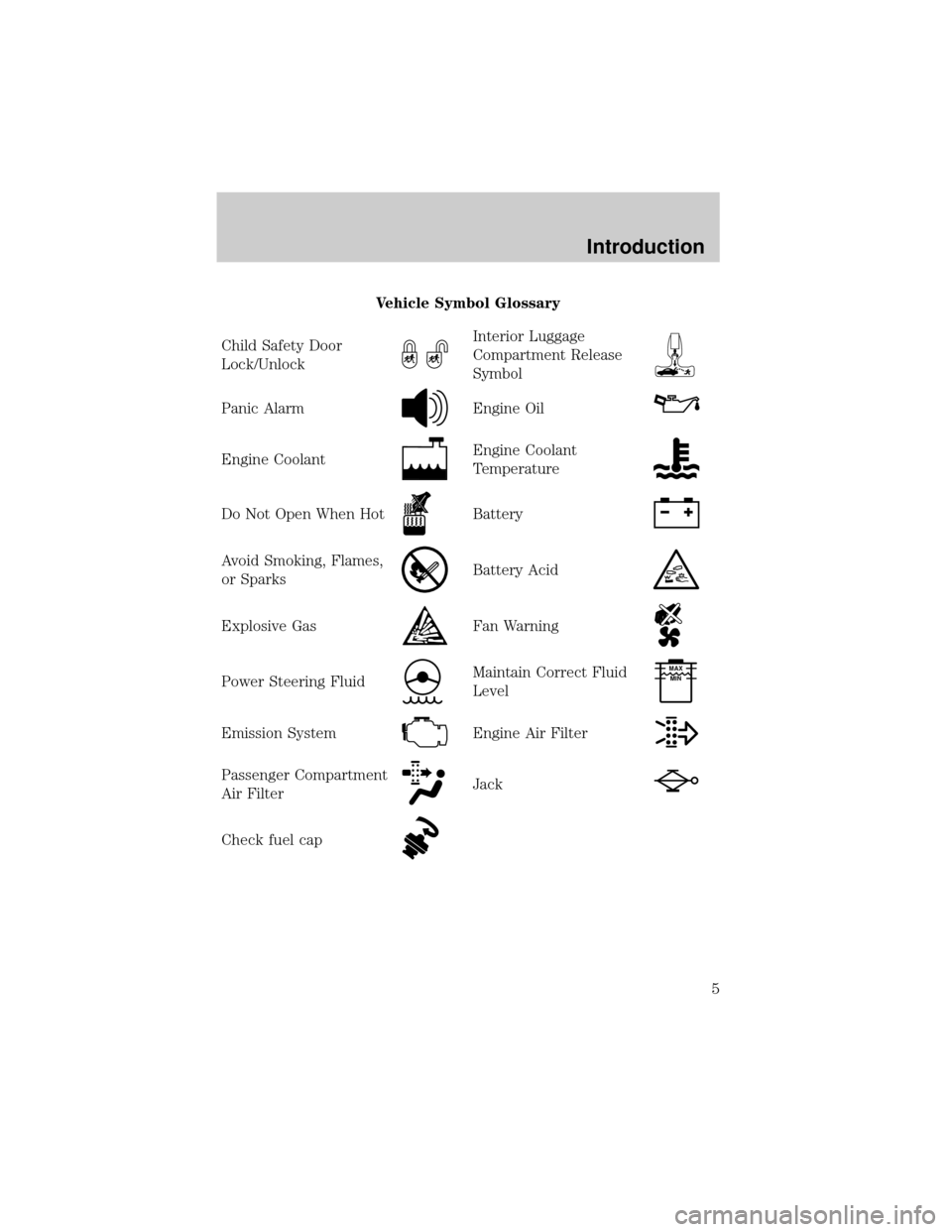coolant temperature Mercury Villager 2001 Owner's Manuals
[x] Cancel search | Manufacturer: MERCURY, Model Year: 2001, Model line: Villager, Model: Mercury Villager 2001Pages: 256, PDF Size: 2.35 MB
Page 5 of 256

Vehicle Symbol Glossary
Child Safety Door
Lock/Unlock
Interior Luggage
Compartment Release
Symbol
Panic AlarmEngine Oil
Engine CoolantEngine Coolant
Temperature
Do Not Open When HotBattery
Avoid Smoking, Flames,
or SparksBattery Acid
Explosive GasFan Warning
Power Steering FluidMaintain Correct Fluid
LevelMAX
MIN
Emission SystemEngine Air Filter
Passenger Compartment
Air FilterJack
Check fuel cap
Introduction
5
Page 17 of 256

²Standard analog instrument
cluster
²Optional electronic instrument
cluster
Engine coolant temperature gauge
Indicates the temperature of the engine coolant. At normal operating
temperature, the needle remains within the normal area (the area
between the ªHº and ªCº). If it enters the red section, the engine is
overheating. Stop the vehicle as soon as safely possible, switch off the
ignition and let it cool. Refer toEngine coolantin theMaintenance
and carechapter.
This gauge indicates the temperature of the engine coolant, not the
coolant level. If the coolant is not at its proper level or mixture, the
gauge indication will not be accurate.
Never remove the radiator cap while the engine is running or
hot.
²Standard analog instrument
cluster
F
E
F
E
1/2
H
C
Instrumentation
17
Page 150 of 256

Make sure the corresponding lights illuminate or illuminate briefly. If a
light fails to illuminate, have the vehicle serviced.
²If the driver's safety belt is fastened, the
light may not illuminate.
STARTING THE ENGINE
NOTE:Whenever you start your vehicle, release the key as soon as the
engine starts. Excessive cranking could damage the starter.
1.
Turn the key to 4 (START) without
pressing the accelerator pedal and
release as soon as the engine starts.
The key will return to 3 (ON).
2. If the temperature is above ±12ÉC
(10ÉF) and the engine does not
start within five seconds on the first
try, turn the key to OFF, wait 10
seconds and try again.
3. If the temperature is below -12É C (10É F) and the engine does not
start in 15 seconds on the first try, turn the key OFF and wait 10
seconds and try again. If the engine does not start in two attempts, Press
the accelerator pedal all the way to floor and hold. Turn the key to
START position.
4. When the engine starts, release the key, then release the accelerator
pedal gradually as the engine speeds up.
5. After idling for a few seconds, apply the brake and release the parking
brake.
Using the engine block heater (if equipped)
An engine block heater warms the engine coolant, which improves
starting, warms up the engine faster and allows the heater-defroster
SERVICE
ENGINE
SOONABSAIR
BAGABSO/D
OFF
OUTSIDE TEMP
INST ECONOMY
AVG. ECONOMY
TO EMPTY
PRND21FUEL DOOR UNLEADED FUEL ONLY CRUISE
MPH
km/h
km
F
EH
C
1/2N
O
R
M
A
L
012345
6
78
P!BRAKE
X 1000
RPMTRIP 1
TRIP 2 ˚F ˚C
MILES/BAL
L/100 km
4
3
2
1
Starting
150
Page 197 of 256
![Mercury Villager 2001 Owners Manuals Severe climates
If you drive in extremely cold climates (less than ±36É C [±34É F]):
²it may be necessary to increase the coolant concentration
above 50%.
²NEVER increase the coolant concentrati Mercury Villager 2001 Owners Manuals Severe climates
If you drive in extremely cold climates (less than ±36É C [±34É F]):
²it may be necessary to increase the coolant concentration
above 50%.
²NEVER increase the coolant concentrati](/img/33/11170/w960_11170-196.png)
Severe climates
If you drive in extremely cold climates (less than ±36É C [±34É F]):
²it may be necessary to increase the coolant concentration
above 50%.
²NEVER increase the coolant concentration above 60%.
²increased engine coolant concentrations above 60% will
decrease the overheat protection characteristics of the engine
coolant and may cause engine damage.
²refer to the chart on the coolant container to ensure the
coolant concentration in your vehicle will provide adequate
freeze protection at the temperatures in which you drive in the
winter months.
If you drive in extremely hot climates:
²it is still necessary to maintain the coolant concentration
above 40%.
²NEVER decrease the coolant concentration below 40%.
²decreased engine coolant concentrations below 40% will
decrease the corrosion protection characteristics of the engine
coolant and may cause engine damage.
²decreased engine coolant concentrations below 40% will
decrease the freeze protection characteristics of the engine
coolant and may cause engine damage.
²refer to the chart on the coolant container to ensure the
coolant concentration in your vehicle will provide adequate
protection at the temperatures in which you drive.
Vehicles driven year-round in non-extreme climates should use a 50/50
mixture of engine coolant and distilled water for optimum cooling system
and engine protection.
CHECKING AND ADDING POWER STEERING FLUID
Check the power steering fluid. Refer to the scheduled maintenance
guide for the service interval schedules. If adding fluid is necessary, use
only MERCONtAT F.
Maintenance and care
197
Page 198 of 256

1. Start the engine and let it run
until it reaches normal operating
temperature (the engine coolant
temperature gauge indicator will be
near the center of the normal area
between H and C).
2. While the engine idles, turn the
steering wheel left and right several
times.
3. Turn the engine off.
4. Check the fluid level in the
reservoir. It should be between the
MIN and MAX lines. Do not add
fluid if the level is in this range.
5. If the fluid is low, add fluid in
small amounts, continuously
checking the level until it reaches
the range between the MIN and
MAX lines. Be sure to put the cap
back on the reservoir.
TRANSMISSION FLUID
Checking automatic transmission fluid
Refer to your scheduled maintenance guide for scheduled intervals for
fluid checks and changes. Your transaxle does not consume fluid.
However, the fluid level should be checked if the transaxle is not working
properly, i.e., if the transaxle slips or shifts slowly or if you notice some
sign of fluid leakage.
Automatic transmission fluid expands when warmed. To obtain an
accurate fluid check, drive the vehicle until it is warmed up
(approximately 30 km [20 miles]). If your vehicle has been
operated for an extended period at high speeds, in city traffic
during hot weather or pulling a trailer, the vehicle should be
turned off for about 30 minutes to allow fluid to cool before
checking.
1. Drive the vehicle 30 km (20 miles) or until it reaches normal operating
temperature.
2. Park the vehicle on a level surface and engage the parking brake.
MAX
MIN
Maintenance and care
198
Page 221 of 256

If the vehicle's powertrain system or its battery has just been serviced,
the on-board diagnostics system is reset to a ªnot ready for I/M testº
condition. To ready the on-board diagnostics system for I/M testing,
follow the procedure described below:
1. Allow the engine to cool to ambient temperature (the engine coolant
temperature gauge indicator will point to C).
2. Start the engine and let it run until it reaches normal operating
temperature (the engine coolant temperature gauge indicator will be
near the center of the normal area between H and C).
3. Accelerate the vehicle to 88 km/h (55 mph), then quickly release the
accelerator pedal completely for at least six seconds.
4. Quickly depress the accelerator pedal for a moment, then drive the
vehicle at a speed of 86 to 96 km/h (53 to 60 mph) for at least five
minutes.
5. Bring the vehicle to a complete stop.
6. Accelerate the vehicle to 55 km/h (35 mph), and maintain the speed
for 20 seconds.
7. Repeat steps five and six at least three times.
8. Accelerate the vehicle to 88 km/h (55 mph), and maintain the speed
for at least three minutes.
9. Bring the vehicle to a complete stop and turn the engine off.
10. Repeat steps one through nine at least one more time.
If step one through eight are interrupted, repeat the preceding step. Any
safe driving mode is acceptable between steps. Once started, do not turn
off the engine until step seven is completed.
BULBS
Replacing exterior bulbs
It is a good idea to check the operation of the following lights frequently:
²Headlamps
²Turn signals
²Cornering lamps
²High-mount brakelamp
²Tail lamps
Maintenance and care
221
Page 250 of 256

A
Accessory delay ..........................91
Air bag supplemental
restraint system ................131±132
and child safety seats ............133
description ..............................132
disposal ....................................136
driver air bag ..........................134
indicator light .....................8, 135
operation .................................134
passenger air bag ...................134
Air cleaner filter ...............200, 232
Air conditioning ..........................24
automatic temperature
control system ..........................31
Air filter, cabin ..........................203
Antifreeze
(see Engine coolant) ................193
Anti-lock brake system
(see Brakes) ......................152±153
Anti-theft system ......................104
arming the system ..................104
disarming a
triggered system .....................105
disarming an untriggered
system .....................................105
Audio system (see Radio) .........42
Automatic transaxle .................155
driving with .............................156
fluid, adding ............................198
fluid, checking ........................198
fluid, refill capacities ..............232
fluid, specification ..................234
Auxiliary power point .................81
Axle
lubricant specifications ..........233B
Battery .......................................201
acid, treating emergencies .....201
charging system warning light ..8
jumping a disabled battery ....179
maintenance-free ....................201
replacement, specifications ...232
servicing ..................................201
Brakes ........................................152
anti-lock ...........................152±153
anti-lock brake system
(ABS) warning light .........11, 153
brake warning light ....................9
fluid, checking and adding ....192
fluid, refill capacities ..............232
fluid, specifications .........233±234
lubricant specifications ..233±234
parking ....................................153
shift interlock ..........................155
Break-in period .............................3
C
Capacities for refilling fluids ....232
Cargo cover ...............................108
Cargo net ...................................107
CD changer .................................76
Certification Label ....................236
Child safety restraints ..............136
child safety belts ....................136
Child safety seats ......................137
attaching with tether straps ..142
in front seat ............................139
in rear seat ......................139, 141
LATCH .....................................146
tether anchorage hardware ...143
Cleaning your vehicle ...............226
Index
250
Page 252 of 256

Engine block heater .................150
Engine oil ..................................189
checking and adding ..............189
dipstick ....................................189
filter, specifications ........191, 232
recommendations ...................191
refill capacities ........................232
specifications ..................233±234
Exhaust fumes ..........................151
F
Floor mats .................................100
Fluid capacities .........................232
Foglamps .....................................23
Fuel ............................................211
calculating fuel economy .......216
cap ...........................................213
capacity ...................................232
choosing the right fuel ...........214
comparisons with EPA fuel
economy estimates .................219
detergent in fuel .....................215
filling your vehicle
with fuel ..................211, 213, 216
filter, specifications ........216, 232
fuel pump shut-off switch .....167
gauge .........................................16
improving fuel economy ........216
low fuel warning light ..............11
octane rating ...................215, 234
quality ......................................215
running out of fuel .................216
safety information relating to
automotive fuels .....................211
Fuses ..................................168±169G
Garage door opener ....................94
Gas cap (see Fuel cap) ............213
Gas mileage
(see Fuel economy) .................216
Gauges .........................................14
engine coolant
temperature gauge ...................17
fuel gauge ..................................16
odometer ...................................15
speedometer .............................15
trip odometer ............................16
GAWR
(Gross Axle Weight Rating) .....160
calculating ...............................161
definition .................................160
driving with a heavy load ......160
location ....................................160
GVWR (Gross
Vehicle Weight Rating) .............160
calculating .......................160±161
definition .................................160
driving with a heavy load ......160
location ....................................160
H
Hazard flashers .........................167
Head restraints .........................110
Headlamps ...................................22
aiming ......................................226
autolamp system .......................23
bulb specifications ..................225
flash to pass ..............................22
high beam ...........................10, 22
replacing bulbs .......................222
turning on and off ....................22
warning chime ..........................13
Index
252